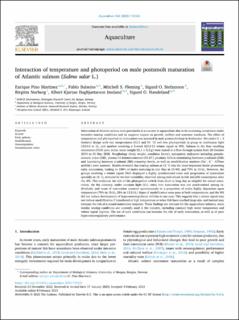| dc.description.abstract | Maturation of Atlantic salmon male postsmolts is a concern in aquaculture due to its increasing occurrence under intensive rearing conditions and its negative impact on growth, welfare and seawater readiness. The effect of temperature and photoperiod on maturation was assessed in male postsmolts kept in freshwater. We used a 2 × 2 factorial design with two temperatures (12.5 and 15 °C) and two photoperiods (a group in continuous light LD24:0 or LL, and another receiving a 5-week LD12:12 winter signal or WS). Salmon in the four resulting treatments (1000 parr, initial mean weight 52.1 ± 5.2 g) were reared in a flow-through system from 28 October 2019 to 30 May 2020. Morphology (body weight, condition factor), maturation indicators including gonadosomatic index (GSI), plasma 11-Ketotestosterone (11-KT), pituitary follicle-stimulating hormone β-subunit (fshb) and luteinizing hormone β-subunit (lhb) transcript levels, as well as smoltification markers (Na+, K+- ATPase activity) were assessed. Results revealed that rearing salmon at 15 °C was the most important factor promoting early maturation, leading to 100% of males maturing in late May in 15-WS, and 75% in 15-LL. However, the groups receiving a winter signal (WS) displayed a highly synchronized onset and progression of maturation specially at 15 °C, revealed by the low variability observed among individuals in GSI and fshb transcription after the WS. This evidences the role of the photoperiod switch from short to long day as zeitgeber for sexual maturation. On the contrary, under constant light (LL), entry into maturation was not synchronized among individuals, and onset of maturation occurred spontaneously in a proportion of males highly dependent upon temperature (75% in 15-LL, 25% in 12.5-LL). Signs of smoltification were poor at both temperatures, and the WS did not induce development of hypo-osmoregulatory abilities in any case. This suggests that a winter signal may not induce smoltification if introduced at high temperature or when fish have reached large size, and instead may increase the risk of a sexual maturation response. These findings are relevant for the aquaculture industry, since similar rearing conditions are currently used in the industry, including constant high water temperature and winter signal regimes. The use of such conditions can increase the risk of early maturation, as well as of poor hypo-osmoregulatory performance. | en_US |
